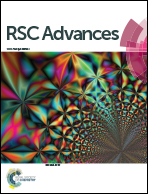The interaction mechanism between alkaloids and pepsin based on lum-AuNPs in the chemiluminescence analysis
Abstract
Herein, novel luminol functional gold nanoparticles (lum-AuNPs) were quickly prepared in an alkaline luminol solution with HAuCl4, which had the unique characteristics of uniform size and excellent luminescence properties. A self-made flow injection-chemiluminescence (FI-CL) system was established to study the interaction between pepsin (Pep) and five alkaloids (anisodamine, berberine, reserpine, jatrorrhizine and matrine) using lum-AuNPs as the CL probe. Based on the abovementioned home-made CL system, the possible interaction mechanisms of Pep with five alkaloids have been comprehensively discussed by molecular docking simulation, chemical thermodynamics and kinetic studies. The results indicated that there were obvious CL enhancement and inhibition effects on the lum-AuNPs CL system for the Pep and the complex of Pep/alkaloids, respectively. The possible mechanism for the interaction of Pep–five alkaloids was mainly mediated by the hydrophobic force. The binding constant K and binding site n for the Pep–alkaloid interaction are consistent with the list of Ber > Res > Ani, Jat > Mat, which is relative to the potential of groups of alkaloids interacting with the active site of Pep.



 Please wait while we load your content...
Please wait while we load your content...